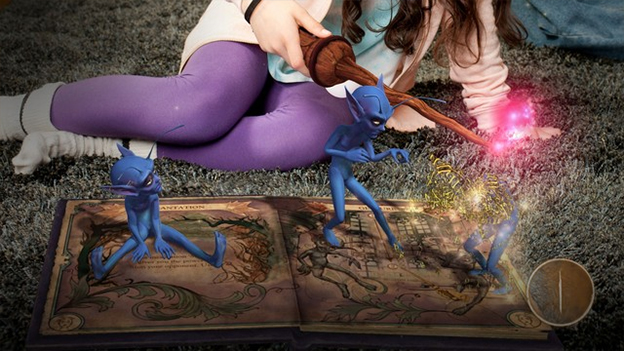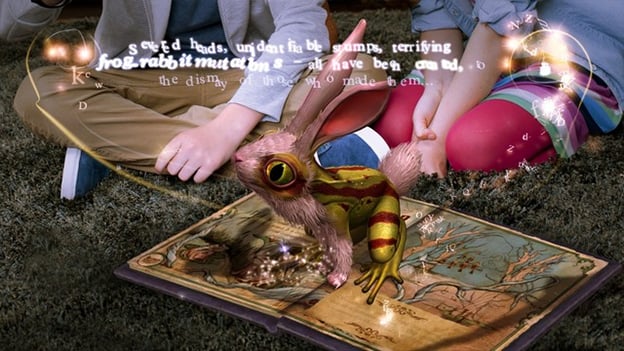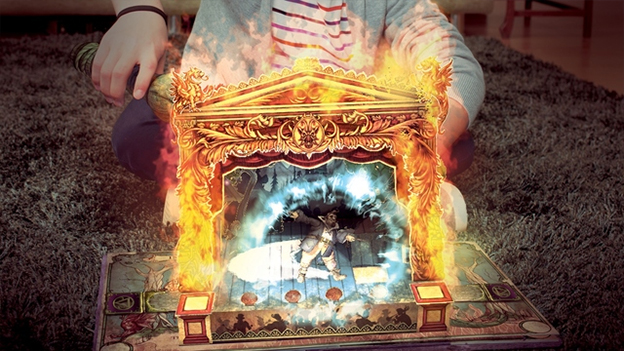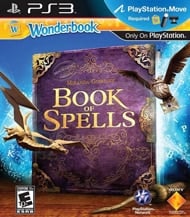The Wonderbook Isn’t Quite Magical, But It’s Close.
Normally, when I bring a new game home, I don’t force my wife to stand there and watch me unbox it. But when I finally got my hands on Sony’s new Wonderbook, we had a quaint little unboxing ceremony. Some people might even call it romantic, but none of those people are my wife.
At the end of the ceremony, after I had explained what the Wonderbook does and how Sony’s augmented reality technology works, she shook her head and started walking away. “I don’t get it,” she said. So, because I’m a male who can’t possibly let anything go unexplained, I hurriedly plugged everything in to my PS3, fired up Book of Spells, and handed her the Move controller. She’s been playing ever since.

See, the thing that makes the Wonderbook brilliant is the same thing that made the Wii brilliant five years ago: It has a strange little charm, and you have to play it to understand. It’s never going to become a hardcore gamer’s peripheral of choice, but that doesn’t mean that it won’t find its place in the gaming industry.
However, unlike the Wii, the Wonderbook has a certain set of flaws that are reminiscent of those strange NES peripherals from back in the 90s. Remember those? The Power Pad, the Power Glove, and all of those other “Power” peripherals looked cool in Nintendo’s commercials, but when you actually tried to use them, you felt guilty for wasting your mom’s money.
Just kidding. I never felt guilty.
In the same way, Sony’s Wonderbook is a genuinely interesting piece of technology, but I worry that it has such a limited scope and so many little quirks that it won’t be able to capture any kind of broad base appeal. And if it doesn’t, those quirks may never get worked out. After all, the only way a hardware manufacturer can justify continued research on their product is if consumers are actually interested.

At the moment, the only title available for the augmented reality hardware is J.K Rowling’s wizarding experience: Book of Spells. The game puts players into the roll of a student at the Hogwarts School of Witchcraft and Wizardry, which is obviously set in the Harry Potter universe. You won’t get to hang out with Potter himself, but the connection to the books and film series is instantly appreciable.
Introducing consumers to the Wonderbook using the Harry Potter universe was really a brilliant idea on Sony’s part. Not only does the setting perfectly match the technology, but the series has a literary foundation, which highlights the hardware’s bookish underpinnings. Sony developers also benefitted from the well-established art direction of the Potter films.

In the game, players get their hands on an antique copy of the Book of Spells, an incantation textbook written by Miranda Goshawk. The book is essentially a guide to the ins and outs of spellcasting, and as you physically turn the pages of the Wonderbook, your training progresses.
Along the way, the narrator feeds you a little background information about the spells, which are firmly rooted in the Harry Potter mythology. J.K. Rowling’s storytelling style is actually better represented in this medium than it ever was in the film series. The narration and lighthearted graphics fit perfectly into Rowling’s well-established world.
In order to prove to your instructor that you actually have been paying attention, you are asked to put your spells into practice at the end of every lesson. This involves sitting up straight and using the PlayStation Move controller as a magic wand. The motion is picked up by the PlayStation Eye and traced onto your television screen. If your movements match the wand motion that was covered in the lesson, you pass.
By now I’m sure you’re all familiar with motion controls, so none of these wand motions sound too terribly impressive. However, the centerpiece of Book of Spells is the Wonderbook itself. If you’re not familiar with the technology, it’s relatively straightforward on paper. The Wonderbook looks and feels like a standard children’s book, only the inside pages are filled with large, geometric QR codes instead of pictures of Dora the Explorer. The QR codes are detected by the PlayStation Eye, which determines the location, orientation, and page number of the book.
For this particular game, the PlayStation Eye works as a mirror, projecting an image of you, the book, and a particularly messy living room, in my case. However, on the screen, the Wonderbook is transformed into a magical pop-up book, which responds to wizard-like waves of the motion controller.
The technology is flawlessly unitized to blend your reality into the wizarding universe. Right out of the gate, and in classical Harry Potter style, players get a chance to utilize the PlayStation Eye to create their own moving picture, just like we’ve all undoubtedly seen in the films. And as you complete the chapters, you’ll get to perform many quintessentially Potterian spells like Incendio and Expelliarmus.
However, even the interest of hardcore Harry Potter fans probably won’t stay piqued for very long. The story moves quickly and the puzzles are not difficult. I’m obviously a couple of decades north of this game’s primary demographic, but considering the age range of the Harry Potter fan base, this is a valid concern. Even so, younger players will have no problem flying through the Book Of Spells, and once it has been completed, the replay value is probably going to be non-existent.

The other problem that players will have to overcome is one that they might not be able to forgive; the technology has some major issues. The PlayStation Eye doesn’t always detect the QR codes effectively, which causes the book to be displayed as a giant blurry splotch in the middle of your living room carpet.
The interaction between the controller and Wonderbook can often be quirky as well. A simple task like making a selection can often take several failed attempts. Also, things like lights, shadows, movement and slight camera adjustments can cause the Eye to lose its fix on the Wonderbook.
But even with all of its problems, I genuinely love the technology. It feels like a strangely inventive step forward for Sony. And, if developers can get behind the tech, we might see a string of educational and entertainment titles hit the market soon. That’ll just depend on the bugs getting worked out of the system.
Plus, I love that developers will be making the line between literature and technology even blurrier. That ought to shut those librarians up.
RATING OUT OF 5 RATING DESCRIPTION 3.5 Graphics
Nothing fancy, but perfectly suited for the game. 2.5 Control
Clever and interesting, but often frustrating. 4.0 Music / Sound FX / Voice Acting
The developers didn’t take any risks, but that’s not a bad thing. 4.0 Play Value
The game itself is fun and engaging, but the replay value is nonexistent. 3.5 Overall Rating – Good
Not an average. See Rating legend below for a final score breakdown.
| Review Rating Legend | |||
|---|---|---|---|
| 0.1 – 1.9 = Avoid | 2.5 – 2.9 = Average | 3.5 – 3.9 = Good | 4.5 – 4.9 = Must Buy |
| 2.0 – 2.4 = Poor | 3.0 – 3.4 = Fair | 4.0 – 4.4 = Great | 5.0 = The Best |
Game Features:
